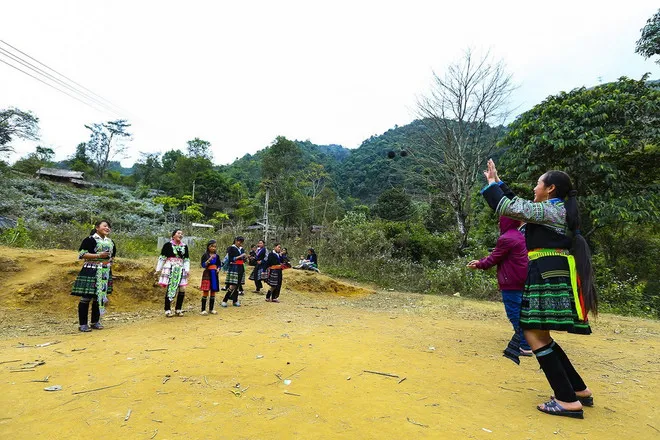Highland markets in Northwest Vietnam are more than just trading places; they are the soul and heart of the region. Each market session is a vibrant, colorful tapestry where visitors can immerse themselves in unique cultural spaces, savor distinctive cuisine, and feel the bustling rhythm of life of ethnic minority communities. Join “Du lịch khắp thế gian” (Travel Around the World) to discover the unmissable experiences of highland markets, where culture, history, and cuisine intertwine, creating a meaningful journey of discovery.
Highland Markets: Beyond a Typical Market
Highland markets are not merely locations for buying and selling goods. They are an indispensable part of the cultural and spiritual life of the highland people. These markets reflect not only the economy but also vividly demonstrate community life, customs, and the cultural identity of each ethnic group. Each market session is an opportunity for people from remote villages to gather, meet, exchange cultures, share experiences, and strengthen solidarity.
Visiting a highland market, you will be immersed in a bustling, colorful space filled with traditional costumes, the lively sounds of “khèn” (pan-pipe-like instrument), flutes, and laughter. More than just a shopping destination, the market is also a cultural stage, hosting folk art performances, traditional games, and unique rituals.
Discovering Cultural Diversity at Highland Markets
Highland markets are a convergence of cultural essence from various ethnic groups such as Hmong, Dao, Thai, Tay, Nung, and more. Each ethnic group brings to the market their distinctive products, showcasing unique cultural identities. From vibrant brocade costumes, exquisite jewelry, unique musical instruments to sophisticated handicrafts, all create a diverse and rich cultural picture.
Visitors can learn about the traditional brocade weaving of the Hmong people through indigo-dyed linen fabrics and colorful floral skirts. Or admire the unique embroidery techniques of the Dao people on their costumes and household items. The market is also a place to introduce the distinctive culinary cultures of each ethnic group, from cooking methods to dining rituals.
Savoring Unique Highland Cuisine and Specialties
The cuisine of highland markets is an unmissable experience. This is where you can find specialty dishes, rich in mountain flavors, prepared according to the traditional recipes of ethnic communities. Visitors can enjoy the flavorful “thắng cố” (horse meat hotpot), the chewy and savory “mèn mén” (steamed corn flour), eye-catching five-colored sticky rice, rich “thịt trâu gác bếp” (smoked buffalo meat), fragrant smoked sausages, or sip on a cup of strong, spicy corn wine fermented with leaf yeast.
Beyond the unique flavors, highland market cuisine also carries deep cultural values. Each dish is associated with historical stories, customs, and the spiritual life of the people. Enjoying food at the market is not just a taste experience but also an opportunity to understand more deeply about the culture and people of the highlands.
Experiencing Cultural Activities and Folk Games
Highland markets attract visitors not only with goods and cuisine but also with unique cultural and artistic activities. On market days, the atmosphere becomes more vibrant and bustling than ever with the melodious sounds of “khèn” and flutes, graceful dances, and lively folk games.
Visitors can immerse themselves in the festive atmosphere with Thai “xòe” dances, Hmong “khèn” dances, “nhảy sạp” (bamboo dance), and more. Participate in traditional games such as “ném còn” (throwing fabric ball), tug-of-war, stick pushing, top spinning, and more to experience the joyful, exciting atmosphere and learn more about the community cultural life of the highland people.
Shopping for Unique Souvenirs with Market Imprints
Highland markets are a paradise for shopping for unique and meaningful souvenirs. Visitors can find countless exquisite handicrafts, vibrant brocade costumes, unique jewelry, specialty agricultural products, and local products imbued with highland imprints.
Souvenirs from the market are not just items but also memories of a memorable cultural exploration journey. It could be a sophisticated hand-embroidered “Khăn Piêu” scarf of the Thai people, a delicate silver bracelet engraved with patterns of the Hmong people, or simply a package of fragrant Shan Tuyet tea, or a jar of pure forest honey.
Tips for a Fulfilling Highland Market Experience
To have a fulfilling and meaningful highland market experience, visitors should note a few things:
- Find out the market time and location: Highland markets usually take place on weekends or holidays. Visitors should find out information about the market time and location in advance to arrange a suitable schedule.
- Prepare appropriate attire: Choose comfortable, modest clothing suitable for the highland weather. Choose easy-to-walk shoes for convenient movement in the market.
- Bring cash: Highland markets mainly use cash, so visitors should prepare enough cash for shopping and spending.
- Respect local culture: When visiting the market, visitors should respect the culture and customs of the local people. Ask for prices before buying and maintain general hygiene.
- Enjoy food selectively: Highland market cuisine is very diverse and rich, but visitors should choose reputable eateries that ensure food safety and hygiene.
- Interact with locals: The market is a great opportunity for visitors to interact and chat with local people, learn about the cultural life and people of the highlands.
Conclusion
Experiencing highland markets is a journey of discovering unique and colorful culture. This place is not only an attractive tourist destination but also a vibrant cultural space where visitors can immerse themselves in the rhythm of life of the highland people, explore traditional cultural values, and enjoy distinctive cuisine. Come to the highland markets to feel and discover the hidden beauty of the land and people of Northwest Vietnam; this will surely be an unforgettable travel experience in your journey to discover Vietnam.
